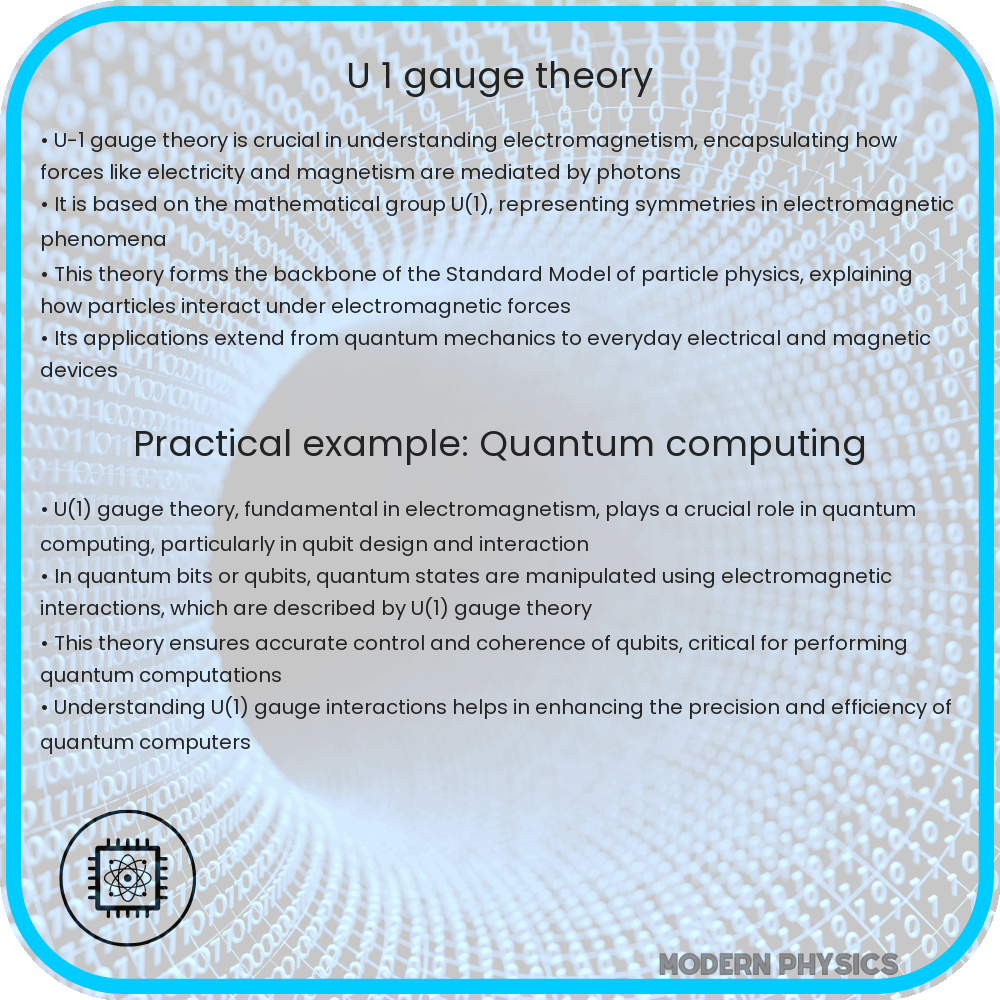Explore U(1) Gauge Theory and its role in quantum fields and electrodynamics, delving into symmetry, QED, and the fundamentals of particle physics.

Understanding U(1) Gauge Theory: Foundations in Quantum Fields and Electrodynamics
The realm of quantum field theory (QFT) and electrodynamics encompasses a variety of complex and fundamental concepts, one of which is the U(1) gauge theory. This theory plays a pivotal role in our understanding of electromagnetic interactions and is a cornerstone of the Standard Model of particle physics. It provides a framework for understanding how particles like electrons and photons interact, and it’s based on the principles of gauge symmetry and field theory.
At its core, U(1) gauge theory is an example of an Abelian gauge theory. ‘U(1)’ refers to the unitary group of degree 1, a mathematical group that represents the simplest non-trivial symmetry group. This symmetry is crucial in quantum electrodynamics (QED), the quantum theory of the electromagnetic field. QED, a subset of the U(1) gauge theory, describes how light and matter interact and is one of the most accurate theories in physics.
The beauty of U(1) gauge theory lies in its simplicity and power. It starts with the premise that the laws of physics should not depend on the particular choice of local phase of the quantum field. This requirement leads to the introduction of a compensating field – the electromagnetic field. In more technical terms, the gauge symmetry under consideration is the invariance under local U(1) phase transformations. Mathematically, this can be expressed as:
Ψ(x) → Ψ'(x) = eiθ(x)Ψ(x)where Ψ(x) is the wave function of a particle, θ(x) is the phase shift which depends on the position x, and i is the imaginary unit.
The introduction of a gauge field, in this case, the electromagnetic field, is necessary to maintain the symmetry of the system. This field is represented by the photon in quantum field theory. The interaction between charged particles and the electromagnetic field is mediated by these photons, which are the quanta of the electromagnetic field.
One of the most significant outcomes of U(1) gauge theory is the derivation of Maxwell’s equations, which govern classical electrodynamics. In the framework of QFT, these equations emerge naturally from the requirement of gauge invariance under U(1) transformations. This shows how quantum theories can provide a deeper understanding of classical phenomena.
Furthermore, the U(1) gauge theory also introduces the concept of charge quantization. This principle states that the electric charge is always an integer multiple of a fundamental unit. This idea is crucial for understanding the discrete nature of charge in quantum mechanics.
Delving Deeper into U(1) Gauge Theory: Quantum Electrodynamics and Symmetry
The U(1) gauge theory, as a foundational aspect of quantum electrodynamics (QED), provides a comprehensive framework for understanding the fundamental interactions between charged particles and the electromagnetic field. This theory is not only pivotal in the realm of high-energy physics but also has profound implications in other areas of physics, including condensed matter and quantum computing.
A key feature of U(1) gauge theory is its ability to explain the electromagnetic force as a gauge interaction. This is achieved through the concept of gauge invariance, which essentially states that certain physical properties of a system remain unchanged (invariant) under local transformations. In the context of QED, this invariance is under local U(1) phase transformations, leading to the conservation of electric charge. This invariance is not just a mathematical artifact but a fundamental symmetry of nature, reflecting the uniformity and consistency of physical laws throughout the universe.
The mathematical formalism of U(1) gauge theory is both elegant and complex. It employs various tools from differential geometry and group theory, such as fiber bundles and Lie groups, to describe the interactions between fields and particles. The gauge field (the electromagnetic field in the case of U(1) gauge theory) is represented by a connection on a principal fiber bundle, while the matter fields (like electrons) are represented by sections of associated vector bundles. This sophisticated mathematical framework not only underpins the Standard Model but also guides physicists in the search for new theories beyond it.
One of the triumphs of U(1) gauge theory, and QED in particular, is its predictive power. It has been tested to an extraordinary degree of accuracy. For instance, the theory’s predictions of the anomalous magnetic moment of the electron and the Lamb shift in hydrogen atoms have been confirmed by experiments to a remarkable precision. These successes not only validate the theory but also showcase the power of theoretical physics in predicting and explaining natural phenomena.
Conclusion
In conclusion, U(1) gauge theory is a fundamental aspect of our understanding of the quantum world, particularly in the realm of electrodynamics. Its principles of gauge symmetry and field interactions form the bedrock of quantum field theory and have significant implications across various domains of physics. The elegance and accuracy of U(1) gauge theory, as exemplified in QED, not only provide deep insights into the nature of electromagnetic interactions but also continue to inspire and guide physicists in the exploration of the quantum universe. Its mathematical rigor and predictive power stand as a testament to the beauty and precision of theoretical physics, offering an ever-evolving window into the mysteries of the universe.
